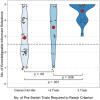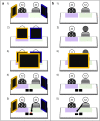Children transition from simple associations to explicitly reasoned social learning strategies between age four and eight
- PMID: 35322165
- PMCID: PMC8943005
- DOI: 10.1038/s41598-022-09092-1
Children transition from simple associations to explicitly reasoned social learning strategies between age four and eight
Abstract
To differentiate the use of simple associations from use of explicitly reasoned selective social learning, we can look for age-related changes in children's behaviour that might signify a switch from one social learning strategy to the other. We presented 4- to 8-year-old children visiting a zoo in Scotland (N = 109) with a task in which the perceptual access of two informants was determined by the differing opacity of two screens of similar visual appearance during a hiding event. Initially success could be achieved by forming an association or inferring a rule based on salient visual (but causally irrelevant) cues. However, following a switch in the scenario, success required explicit reasoning about informants' potential to provide valuable information based on their perceptual access. Following the switch, older children were more likely to select a knowledgeable informant. This suggests that some younger children who succeeded in the pre-switch trials had inferred rules or formed associations based on superficial, yet salient, visual cues, whereas older children made the link between perceptual access and the potential to inform. This late development and apparent cognitive challenge are consistent with proposals that such capacities are linked to the distinctiveness of human cumulative culture.
© 2022. The Author(s).
Conflict of interest statement
The authors declare no competing interests.
Figures





Similar articles
-
Detecting lies through others' eyes: Children use perceptual access cues to evaluate listeners' beliefs about informants' deception.J Exp Child Psychol. 2024 May;241:105863. doi: 10.1016/j.jecp.2024.105863. Epub 2024 Feb 1. J Exp Child Psychol. 2024. PMID: 38306738
-
Colorful success: preschoolers' use of perceptual color cues to solve a spatial reasoning problem.J Exp Child Psychol. 2012 Dec;113(4):523-34. doi: 10.1016/j.jecp.2012.06.012. Epub 2012 Aug 9. J Exp Child Psychol. 2012. PMID: 22878085
-
Developmental differences in the relative weighing of informants' social attributes.Dev Psychol. 2013 Mar;49(3):602-13. doi: 10.1037/a0031674. Epub 2013 Jan 28. Dev Psychol. 2013. PMID: 23356527
-
A developmental intergroup theory of social stereotypes and prejudice.Adv Child Dev Behav. 2006;34:39-89. doi: 10.1016/s0065-2407(06)80004-2. Adv Child Dev Behav. 2006. PMID: 17120802 Review.
-
Content counts: A trait and moral reasoning framework for children's selective social learning.Adv Child Dev Behav. 2020;58:95-136. doi: 10.1016/bs.acdb.2020.01.004. Epub 2020 Mar 2. Adv Child Dev Behav. 2020. PMID: 32169200 Review.
References
-
- Dean LG, Vale G, Laland KN, Flynn EG, Kendal R. Human cumulative culture: A comparative perspective. Biol. Rev. 2014;89:284–301. - PubMed
-
- Wilks CEH, Blakey KH. In the jungle of cultural complexity. Evol. Anthropol. 2018;27:180–183. - PubMed
-
- Laland KN. Social learning strategies. Anim. Learn. Behav. 2004;32:4–14. - PubMed
Publication types
MeSH terms
Grants and funding
LinkOut - more resources
Full Text Sources

